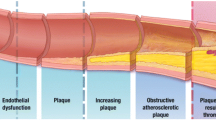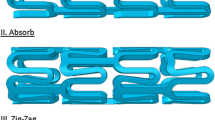Abstract
Atherosclerosis is a progressive disease characterized by the accumulation of lipids and fibrous elements in the arterial wall. This accumulation produces plaque in the arteries. Percutaneous transluminal coronary angioplasty (PTCA) is a minimally invasive procedure that opens narrowed coronary arteries because of the plaque growth. A medical device that can hold an artery open in the area of narrowing is called a stent and it usually resembles a mesh tube. Mechanical stent tests are standard preclinical procedure used to simulate stent behavior for different physiological conditions. In this research, a mechanical test called three-point bending test was performed on a partially and fully bioresorbable vascular scaffold (BVS) manufactured by Boston Scientific Limited [1]. Poly-l-lactic acid (PLLA) material model was implemented for the numerical model inside in-house PAK [2] software. Measurements obtained by mechanical testing were compared with the numerical results. There is a strong correlation between the numerical simulation and real experiments with a coefficient of determination (R2) > 0.99 and a correlation coefficient (R) > 0.99. It can be concluded that in silico mechanical tests can partially or fully replace in vitro stent tests, which can open a new avenue for regulatory submission and change regulatory ISO standard procedures.
Access this chapter
Tax calculation will be finalised at checkout
Purchases are for personal use only
Similar content being viewed by others
References
Jovicic, G., Vukicevic, A., Filipovic, N.: Computational assessment of stent durability using fatigue to fracture approach. J Med Dev 8(4), 041002 (2014). https://doi.org/10.1115/1.4027687
Kojic M, Filipovic N et al (2022). http://www.bioirc.ac.rs/index.php/software/5-pak. Last visited: 29 September 2022
Martin, D., Boyle, F.J.: Computational structural modelling of coronary stent deployment: a review. Comput Methods Biomech Biomed Eng 14(4), 331–348 (2011). https://doi.org/10.1080/10255841003766845
Balossino, R., Gervaso, F., Migliavacca, F., Dubini, G.: Effects of different stent designs on local hemodynamics in stented arteries. J Biomech 41(5), 1053–1061 (2008). https://doi.org/10.1016/j.jbiomech.2007.12.005
LaDisa, J., Hettrick, D., Olson, L., Guler, I., Gross, E., Kress, T., Kersten, J., Warltier, D., Pagel, P.: Stent implantation alters coronary artery hemodynamics and wall shear stress during maximal vasodilation. J Appl Physiol 93(6), 1939–1946 (2002). https://doi.org/10.1152/japplphysiol.00544.2002
LaDisa, J., Olson, L., Guler, I., Hettrick, D., Audi, S., Kersten, J., Warltier, D., Pagel, P.: Stent design properties and deployment ratio influence indexes of wall shear stress: a three-dimensional computational fluid dynamics investigation within a normal artery. J Appl Physiol 97(1), 424–430 (2004). https://doi.org/10.1152/japplphysiol.01329.2003
Pontrelli G, de Monte F (2007) Modelling of mass convection diffusion in stent-based drug-delivery. Paper presented at: XXV Congresso Nazionale UIT sulla Trasmssione del Calore, 18–20 May 2007, Trieste
Zunino, P., D’Angelo, C., Petrini, L., Vergara, C., Capelli, C., Migliavacca, F.: Numerical simulation of drug eluting coronary stents: mechanics, fluid dynamics and drug release. Comput Methods Appl Mech Eng 198, 3633–3644 (2009). https://doi.org/10.1016/j.cma.2008.07.019
Mac Donald BJ (2007) Practical stress analysis with finite elements. Glasnevin Publishing, Dublin
Dumoulin, C., Cochelin, B.: Mechanical behaviour modelling of balloon-expandable stents. J Biomech 33, 1461–1470 (2000). https://doi.org/10.1016/S0021-9290(00)00098-1
Etave, F., Finet, G., Boivin, M., Boyer, J.C., Rioufol, G., Thollet, G.: Mechanical properties of coronary stents determined by using finite element analysis. J Biomech 34(8), 1065–1075 (2001). https://doi.org/10.1016/s0021-9290(01)00026-4
Migliavacca, F., Petrini, L., Montanari, V., Quagliana, I., Auricchio, F., Dubini, G.: A predictive study of the mechanical behaviour of coronary stents by computer modelling. Med Eng Phys 27(1), 13–18 (2005). https://doi.org/10.1016/j.medengphy.2004.08.012
Chua, D., MacDonald, B., Hashmi, M.: Finite element simulation of slotted tube (stent) with the presence of plaque and artery by balloon expansion. J Mater Process Technol 155–156, 1772–1779 (2004). https://doi.org/10.1016/j.jmatprotec.2004.04.396
Chua, D., MacDonald, B., Hashmi, M.: Effects of varying slotted tube (stent) geometry on its expansion behaviour using finite element method. J Mater Process Technol 155–156, 1764–1771 (2004). https://doi.org/10.1016/j.jmatprotec.2004.04.395
Bathe, K.J.: Finite element procedures. Prentice-Hall, Englewood Cliffs, NJ (1996)
De Beule, M., Mortier, P., Carlier, S.G., Verhegghe, B., Van Impe, R., Verdonck, P.: Realistic finite element-based stent design: the impact of balloon folding. J Biomech 41(2), 383–389 (2008). https://doi.org/10.1016/j.jbiomech.2007.08.014
Petrini, L., Migliavacca, F., Auricchio, F., Dubini, G.: Numerical investigation of the intravascular coronary stent flexibility. J Biomech 37, 495–501 (2004). https://doi.org/10.1016/j.jbiomech.2003.09.002
Auricchio, F., Di Loreto, M., Sacco, E.: Finite element analysis of a stenotic artery revascularisation through a stent insertion. Comput Methods Biomech Biomed Eng 4, 249–263 (2001). https://doi.org/10.1080/10255840108908007
Capelli, C., Gervaso, F., Petrini, L., Dubini, G., Migliavacca, F.: Assessment of tissue prolapse after balloon-expandable stenting: influence of stent cell geometry. Med Eng Phys 31(4), 441–447 (2009). https://doi.org/10.1016/j.medengphy.2008.11.002
Holzapfel, G.A., Stadler, M., Gasser, T.C.: Changes in the mechanical environment of stenotic arteries during interaction with stents: computational assessment of parametric stent designs. J Biomech Eng 127(1), 166–180 (2005). https://doi.org/10.1115/1.1835362
Lally, C., Dolan, F., Prendergast, P.J.: Cardiovascular stent design and vessel stresses: a finite element analysis. J Biomech 38(8), 1574–1581 (2005). https://doi.org/10.1016/j.jbiomech.2004.07.022
Karanasiou GS et al (2018) In Silico analysis of stent deployment-effect of stent design. In: 40th annual international conference of the IEEE engineering in medicine and biology society (EMBC), Honolulu, HI, pp 4567–4570. https://doi.org/10.1109/EMBC.2018.8513205
Soares JS, Moore JE (2015) Biomechanical challenges to polymeric biodegradable stents. Ann Biomed Eng 44:560–579. https://doi.org/10.1007/s10439-015-1477-2
Soares JS, Moore Jr JE, Rajagopal KR (2007) Modeling of biological materials. Mollica F, Preziosi L, Rajagopal KR (eds). Birkhauser Basel, pp 125–177
Soares JS, Moore Jr JE, Rajagopal KR (2008) Constitutive framework for biodegradable polymers with applications to biodegradable stents. ASAIO J 54(3):295–301. https://doi.org/10.1097/MAT.0b013e31816ba55a
Soares JS, Rajagopal KR, Moore Jr JE (2010) Deformation-induced hydrolysis of a degradable polymeric cylindrical annulus. Biomech Model Mechanobiol 9:177–186.https://doi.org/10.1007/s10237-009-0168-z
Vieira, A.C., Vieira, J.C., Ferra, J.M., Magalhaes, F.D., Guedes, R.M., Marques, A.T.: Mechanical study of PLA–PCL fibers during in vitro degradation. J Mech Behav Biomed Mater 4, 451–460 (2011). https://doi.org/10.1016/j.jmbbm.2010.12.006
Vieira, A.C., Guedes, R.M., Tita, V.: Constitutive modeling of biodegradable polymers: hydrolytic degradation and time-dependent behavior. Int J Solids Struct 51, 1164–1174 (2014). https://doi.org/10.1016/j.ijsolstr.2013.12.010
Bergstrom, J.S., Boyce, M.C.: Constitutive modeling of the large strain time-dependent behavior of elastomers. J Mech Phys Solids 46, 931–954 (1998). https://doi.org/10.1016/S0022-5096(97)00075-6
O’Brien, B.J., Stinson, J.S., Larsen, S.R., Eppihimer, M.J., Carroll, W.M.: A platinum-chromium steel for cardiovascular stents. Biomaterials 31(14), 3755–3761 (2010). https://doi.org/10.1016/j.biomaterials.2010.01.146
Kojic, M., Bathe, K.J.: Inelastic analysis of solids and structures. Springer, Berlin-Heidelberg-New York (2005)
Kojic M, Filipovic N, Stojanovic B, Kojic N (2008) Computer modeling in bioengineering—theoretical background, examples and software. Wiley, England. 978-0-470-06035-3
Isailovic, V., Kojic, M., Milosevic, M., Filipovic, N., Kojic, N., Ziemys, A., Ferrari, M.: A computational study of trajectories of micro- and nano-particles with different shapes in flow through small channels. J Serbian Soc Comput Mech 8(2), 14–28 (2014). https://doi.org/10.5937/jsscm1402014I
Djukic, T., Saveljic, I., Pelosi, G., Parodi, O., Filipovic, N.: Numerical simulation of stent deployment within patient-specific artery and its validation against clinical data. Comput Methods Prog Biomed 175, 121–127 (2019). https://doi.org/10.1016/j.cmpb.2019.04.005
Krsmanovic D, Filipovic N, Koncar I, Petrovic D, Milasinovic D, Davidovic L (2014) Computer modelling of maximal displacement forces in endoluminal thoracic aortic stent graft. Comput Methods Biomech Biomed Eng 17(9):1012–1020. https://doi.org/10.1080/10255842.2012.735661
Vukicevic, A.M., Stepanovic, N.M., Jovicic, G.R., Apostolovic, S.R., Filipovic, N.D.: Computer methods for follow-up study of hemodynamic and disease progression in the stented coronary artery by fusing IVUS and X-ray angiography. Med Biol Eng Comput 52(6), 539–556 (2014). https://doi.org/10.1007/s11517-014-1155-9
Acknowledgements
This study was funded by the European Project H2020 InSilc [grant number 777119] and Serbian Ministry of Education, Science, and Technological Development [451-03-68/2020-14/200107 (Faculty of Engineering, University of Kragujevac). This chapter reflects only the author’s view. The Commission is not responsible for any use that may be made of the information it contains.
Author information
Authors and Affiliations
Corresponding author
Editor information
Editors and Affiliations
Rights and permissions
Copyright information
© 2023 The Author(s), under exclusive license to Springer Nature Switzerland AG
About this chapter
Cite this chapter
Filipović, N. (2023). Comparison of Numerical Model with Experimental Measurements for the Purpose of Testing Partially and Fully Biodegradable Stents. In: Najman, S., et al. Bioceramics, Biomimetic and Other Compatible Materials Features for Medical Applications. Engineering Materials. Springer, Cham. https://doi.org/10.1007/978-3-031-17269-4_11
Download citation
DOI: https://doi.org/10.1007/978-3-031-17269-4_11
Published:
Publisher Name: Springer, Cham
Print ISBN: 978-3-031-17268-7
Online ISBN: 978-3-031-17269-4
eBook Packages: Chemistry and Materials ScienceChemistry and Material Science (R0)




